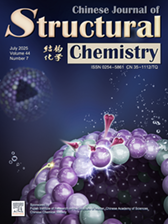
Cover Picture
Neodymium-doped hollow Ir/IrO2 nanospheres with low geometric iridium density enable excellent acidic water oxidation performance
Xiaoqian Wei, Hanyu Gao, Tiantian Wang, Zijian Li, Yanru Geng, Guiping Zheng, Min Gyu Kim, Haeseong Jang*, Xien Liu*, Qing Qin* Submit a Manuscript
Neodymium-doped hollow Ir/IrO2 nanospheres with low geometric iridium density enable excellent acidic water oxidation performance
Xiaoqian Wei, Hanyu Gao, Tiantian Wang, Zijian Li, Yanru Geng, Guiping Zheng, Min Gyu Kim, Haeseong Jang*, Xien Liu*, Qing Qin* Submit a Manuscript
Type-I heterojunction photocatalysis: enhanced activity via ZnIn2S4/MnCo2O4.5 interfacial electric fields
Qiang Yu, Shuhan Sun, Xianming Jin, Ruiqiang Yan, Bingjing He, Nikolay Sirotkin, Alexander Agafonov*, Xianqiang Xiong*, Kangle Lv
Chin. J. Struct. Chem., 2025, 44(7), 100620. DOI: 10.1016/j.cjsc.2025.100620
July 1, 2025
ZnIn2S4; MnCo2O4.5; Ohmic-like type-I heterojunction; Photocatalytic hydrogen evolution
ABSTRACT
The modulation of charge transfer pathways within type-I heterojunctions through interfacial electric field (IEF) engineering is of critical importance in promoting photocatalytic hydrogen evolution, effectively facilitating the separation of photogenerated charge carriers. In this study, we performed in-situ growth of two-dimensional ZnIn2S4 nanosheets on MnCo2O4.5 nanorods to construct an ohmic-like type-I ZnIn2S4/MnCo2O4.5 heterojunction for efficient photocatalytic hydrogen evolution. This ohmic-like charge transfer mechanism effectively addresses the intrinsic limitations inherent to conventional type-I heterojunctions neglecting IEF effects, particularly through IEF-induced enhancement of charge separation efficiency. Consequently, the optimized ZnIn2S4/MnCo2O4.5 photocatalyst demonstrates an outstanding photocatalytic hydrogen evolution rate of 20.9 mmol g−1 h−1, 14.9 times that of the bare ZnIn2S4. Furthermore, the ohmic-like charge transport behavior has been rigorously validated by integrated advanced experimental characterizations, including in-situ X-ray photoelectron spectroscopy (XPS), Kelvin probe force microscopy (KPFM), and surface photovoltage (SPV) measurements, which collectively provide robust evidence for the proposed mechanism. This work offers valuable insights into the design of high-efficient ohmic-like type-I heterojunction catalysts for photocatalytic H2 evolution.







